
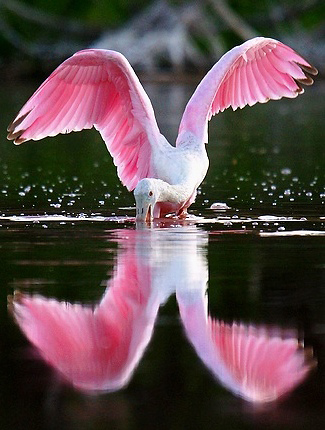
A lovely image of a Roseate Spoonbill, a widespread bird in Central America, taken by Dave Irving.
CENTRAL AMERICA and THE CARIBBEAN
The destinations listed and linked below are the ones we believe are the best in Central America and the Caribbean. They have been chosen very carefully and for a multitude of reasons, but mainly based on personal experience of some of them and on dreams of visiting the rest, dreams resulting from what we have heard, read or seen.
It is our intention to update this list regularly as we add destinations and it was last updated in May 2021.
If there are any other destinations you think should be on the list below then please feel free to Email us.
The destinations are listed alphabetically with very brief summaries for those linked, in dark blue, to more detailed pages (to reach these pages click on the destination name). Those not linked to more detailed pages are described in a bit more detail here, in italics, under light blue headings.
For more information see ...
The Best (100) Birds in the World,
The Best (100) Wildlife in the World and
Best (50) Other Natural Wonders.
Destinations
The first and arguably most important destination to consider is a Local Patch, somewhere a short walk from home where it is possible to see a wide range of birds and other wildlife any day of the year.
B
Bahamas
Eight endemic birds; Inagua Woodstar (Great Inagua), Bahama Lizard-cuckoo, Bahama Swallow, Bahama Nuthatch (may have become extinct due to Hurricane Dorian
in 2019), Northern Red-legged Thrush, Bahama Oriole, Bahama Yellowthroat and Bahama Warbler, as well as near-endemics Bahama Woodstar, Cuban Emerald, West
Indian Woodpecker, Cuban Amazon, La Sagra's Flycatcher, Cuban Pewee and Olive-capped Warbler, and wintering Kirtland's Warblers, all in one of the best
places in the world to swim with dolphins, sharks and sting rays.
Barbados
There is not much natural habitat left on the coral island of Barbados, much more famous for its sugar plantations and white beaches than the few birds
present but they do include the ubiquitous endemic Barbados Bullfinch, as well as Masked Duck, Royal Tern, Scaly-naped Pigeon (more easily seen here than
on many other islands in its Caribbean range), Common Ground-dove, Zenaida Dove, Green-throated Carib, Antillean Crested Hummingbird, Black-whiskered
Vireo, Caribbean Martin, Caribbean Elaenia, Mangrove (Yellow) Warbler (in and around the Graeme Hall Nature Sanctuary mangroves, arguably the best birding
site on the island), Bananaquit, Black-faced Grassquit, Shiny Cowbird and Carib Grackle (a population with males and females in similar plumage). Good
places for shorebirds are Chancery Lane Swamp and Woodbourne Refuge.
Belize
Whale Shark, possibly West Indian Manatee, coral reef fish and spectacular birds including Orange-breasted Falcon, Keel-billed Toucan and Yucatan Jay, with
Great Curassows and Ocellated Turkeys at Tikal just across the border in Guatemala.
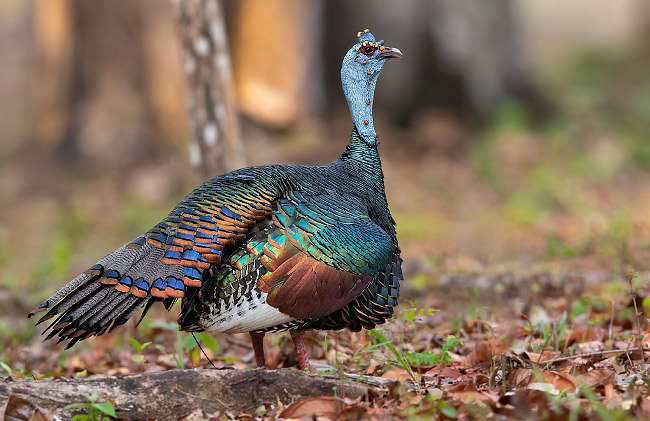
A male Ocellated Turkey at Tikal, Guatemala, by Dubi Shapiro.
C
Cayman Islands
Grand Cayman Bullfinch is the only endemic bird species on these three islands south of Cuba but they do also support Vitelline Warbler which otherwise
occurs only on the Swan Islands off Honduras. There are many endemic subspecies, including two of Cuban Amazon (caymanensis on Grand Cayman and hesterna
on Cayman Brac) and Vitelline Warbler (vitellina on Grand Cayman and crawfordi on Little Cayman). Other specialities include West Indian Whistling-duck,
Antillean Nighthawk, West Indian Woodpecker (Grand Cayman), Loggerhead Kingbird, Caribbean Elaenia, La Sagra's Flycatcher, (Western) Red-legged Thrush,
Thick-billed Vireo, Yucatan Vireo (Grand Cayman), Bananaquit (sharpei), Western Spindalis (Grand Cayman) and Greater Antillean Grackle, while more
widespread spectacular species include White-tailed Tropicbird, Red-footed Booby (one of the largest breeding colonies on Earth (about 3500 pairs) is on
Little Cayman), Magnificent Frigatebird (which also has a breeding colony on Little Cayman), and passage migrant and wintering warblers such as
Black-throated Blue. Most resident breeding species nest from late May to July. The endemic fauna includes the Grand Cayman Blue Iguana while rich coral
reefs, calm seas and warm, clear water make snorkelling and scuba-diving delightful, the most notable larger species being Blacktip and Whitetip Reef
Sharks, Southern Stingray, Spotted Eagle Ray, Green Turtle and Atlantic Tarpon.
Costa Rica
Over 900 bird species in 50,000 sq km including one of the best selections of the world's most spectacular birds, not least Agami Heron, Sunbittern,
Scarlet Macaw, Resplendent Quetzal, Turquoise-browed Motmot, Keel-billed Toucan, Three-wattled Bellbird, Bare-necked Umbrellabird, Lovely Cotinga,
Orange-collared and Red-capped Manakins, Wrenthrush and Long-tailed Silky-flycatcher (one of 74 species shared only with Panama), together with sloths,
howler and spider monkeys, nesting turtles, Red-eyed Tree Frogs, giant dragonflies and numerous butterflies. Costa Rica's got the lot!
Cuba
A big island, home to one of the world’s smallest bats, possibly the dinkiest frog and the smallest bird; the Bee Hummingbird, one of 30 endemics
which also include Blue-headed and Grey-headed Quail-doves, the very rarely seen Zapata Rail, Bare-legged Screech-owl, Cuban Trogon, Cuban Tody,
Fernandina’s Flicker, Zapata Wren, Zapata Sparrow, and Oriente and Yellow-headed Warblers (both now in their own family), all joined by wintering warblers
such as Black-throated Blue, Cape May and Prairie.
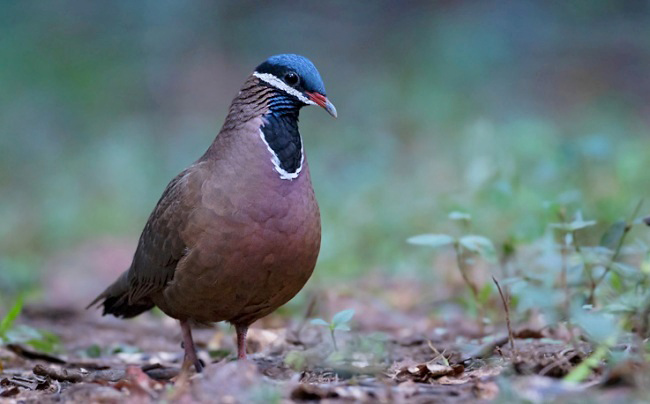
There are a lot of rather spectacular endemic birds on the island of Cuba, not least the Blue-headed Quail-dove. This fine image was captured at Bermejas near Zapata by Dubi Shapiro.
D
Dominica
This small, steep Caribbean island supports two endemic parrots, and near-endemic Blue-headed Hummingbird, Brown Trembler and Plumbeous Warbler but is
perhaps more famous for being one of the best places in the world to see Sperm Whales, along with other whales, and dolphins.
Dominican Republic
Three bird families endemic to the island of Hispaniola which the Dominican Republic shares with Haiti, are represented here by the monotypic Palmchat, the
two Chat Tanagers and three of the four Hispaniolan Tanagers; Black-crowned Palm-tanager, and Green-tailed and White-winged Warblers, 33 of the 34
Hispaniolan endemics in total, also including a parrot, a trogon and two todies. Many visitors head for the nearby Silverbank though, one of the few places
in the world where it is possible to swim with Humpback Whales.
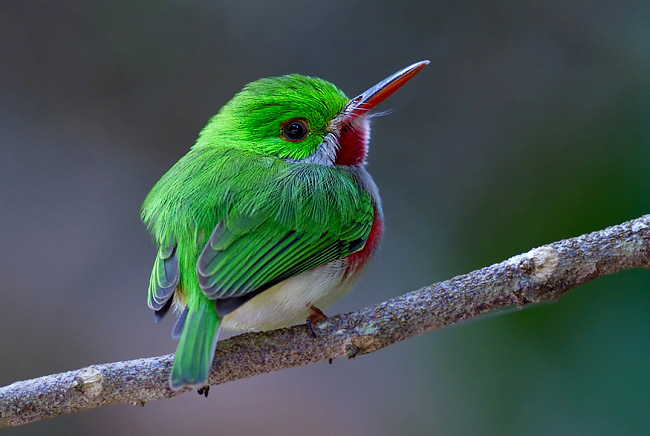
Birds do not come much cuter than todies which are endemic to the Caribbean. This is a Broad-billed Tody on the Sierra de Bahoruco in the Dominican Republic by Dubi Shapiro.
E
El Salvador
The smallest country in Central America has the highest human population density hence there ain’t a lot of forest left. However, all the birds of the
dry tropical forest belt that ranges along the Pacific coast from southern Mexico to northern Costa Rica and many species endemic to the highlands between
southern Mexico and northern Nicaragua are present including Rufous Sabrewing, and Black-throated, Bushy-crested and Unicoloured Jays. The best birding
sites include El Imposible National Park (Long-tailed Manakin), Los Volcanes National Park (Green-throated Mountain-gem, Rufous-browed Wren, Bushy-crested
Jay and Cinnamon-bellied Flowerpiercer), Montecristo National Park (Highland Guan and Rufous-collared Thrush) and the Perquín area (Buffy-crowned
Wood-partridge and Bushy-crested Jay).
El Triunfo - Mexico
See Mexico - El Triunfo, below
G
Guatemala
Although Guatemala is little more than one-twentieth the size of Mexico it has a birdlist of over 750 and is one of the richest areas for birds on
Earth with many Central American endemics including 15 shared only with Mexico. In the south of this country which has some of the most active volcanoes
in the region specialities include Crested and Highland Guans, Spotted Wood-quail, Resplendent Quetzal, hummingbirds such as Rufous and Violet Sabrewings,
Blue-throated and Tody Motmots, Chestnut-sided Shrike-vireo, Bushy-crested and Unicoloured Jays, Pink-headed Warbler and the rare Azure-rumped Tanager,
mostly in patches of remnant forest in and around shade-coffee plantations, and on the highest, steepest slopes of the dramatic volcanic landscape, at
places such as Finca Los Andes. The best spot in the world for the stunning Goldman’s (Myrtle) Warbler, a virtual endemic that also occurs just across the
border in Mexico, is the high-elevation juniper and pine forests of Todos Santos Cuchumatan near Huehuetenango where there is also a chance of Ocellated
Quail, Olive Warbler and the Guatemalan subspecies of Yellow-eyed Junco. On the high slopes of Volcan San Pedro around the beautiful crater lake Lago de
Atitlan (where the endemic grebe became extinct in about 1985) it is also possible to see the localised, rare and spectacular Horned Guan, above 2500 m
(8,200 ft) on the notoriously steep El Sendero de Lagrimas (The Trail of Tears), as well as Amethyst-throated Mountain-gem, Sparkling-tailed Woodstar,
Wine-throated Hummingbird, Blue-throated Motmot and Hooded Grosbeak. Up north is the Classic Mayan site of Tikal where the birdlife includes several
Yucatan endemics such as Ocellated Turkey, Yucatan Poorwill and Grey-throated Chat, with numerous other spectacular birds, not least King Vulture and
Keel-billed Toucan, as well as Black (Yucatan) Howler Monkey, Central American (Geoffrey's) Spider Monkey and confiding White-nosed Coatis. The peak time
to look for birds is January to April.
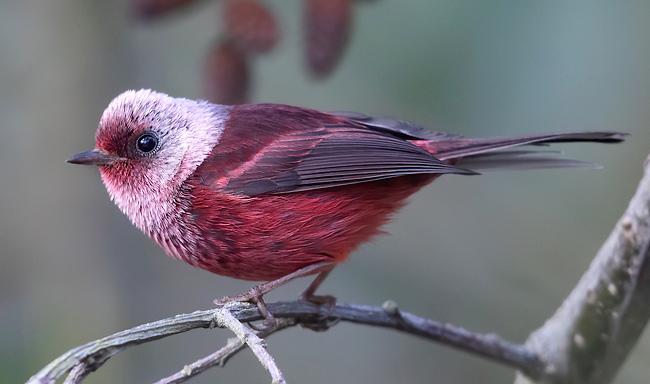
Pink-headed Warbler at Sibinal in Guatemala by Dubi Shapiro. This beauty occurs only in Guatemala and the adjacent highlands of eastern Chiapas in southern Mexico.
H
Haiti
The island of Hispaniola supports over 30 endemic bird species although one, Grey-crowned Palm-tanager, is confined to Haiti, at the western end of the
island shared with the Dominican Republic. This rare endemic, known to the locals as ‘Quatre-yeux’ (Four-eyes) because of the white areas around the eyes,
can be seen around the Saut Mathurine waterfall in the last pristine cloudforest in the country in Pic Macaya National Park near Les Cayes, 196
km west of the capital Port-au-Prince. Also present in and around the park are West Indian Whistling-duck, Broad-billed Tody, Palmchat (both at the
botanical gardens) and many other species which also occur in the Dominican Republic. As for the rest of Haiti well this is the poorest, most
environmentally degraded country in the Caribbean, a country composed mainly of rugged highlands rising to 2674 m at Pic La Selle in the southeast. The
slopes of these mountains were once cloaked in beautiful forests but only tiny fragments remain and therefore few tree-dwelling birds, but the peaks do
support the only known significant breeding populations of Black-capped Petrel. The best time to visit is mid-March to mid-April when many resident birds
start to breed and wintering species are joined by spring migrants heading to North America.
Honduras
Many Central American endemic birds including the sole endemic, Honduran Emerald, Spot-bellied Bobwhite, Red-throated Parakeet, the near-endemic
Green-breasted Mountain-gem, Snowcap, Blue-throated, Keel-billed and Turquoise-browed Motmots, Bushy-crested Jay, Snowy Cotinga, Three-wattled Bellbird and
Grey-headed Piprites, as well as coral reef fish and one of the best places in the world to swim with Whale Sharks.
J
Jamaica
This small tropical island supports a staggering 31 endemic bird species (not including Jamaican Oriole which occurs only on Jamaica and the remote
island of San Andres), many of which are widespread. They include a quail-dove, two superb streamer-tailed hummingbirds, a tody, two parrots, two vireos,
two thrushes, a euphonia, a warbler and a spindalis. The quail-dove is most likely to be seen, like several other endemics, along Ecclesdown Road in the
John Crow Mountains, although the lizard-cuckoo and blackbird are most likely at Hardwar Gap in the Blue Mountains. Other, more widespread, Caribbean
endemics present include West Indian Whistling-duck, Vervain Hummingbird and Rufous-throated Solitaire, and other spectacular species include White-tailed
Tropicbird (at Hector's River), Magnificent Frigatebird, Northern Potoo (the endemic jamaicensis race) and wintering warblers from North America,
including Black-throated Blue, Cape May and Prairie. There are some spectacular butterflies too, not least the rarely reported endemic Giant Swallowtail
(Papilio homerus) which with a wingspan of up to 15 cm is the largest swallowtail butterfly in the Americas. The best time to look for birds is
February to early May, later for butterflies.
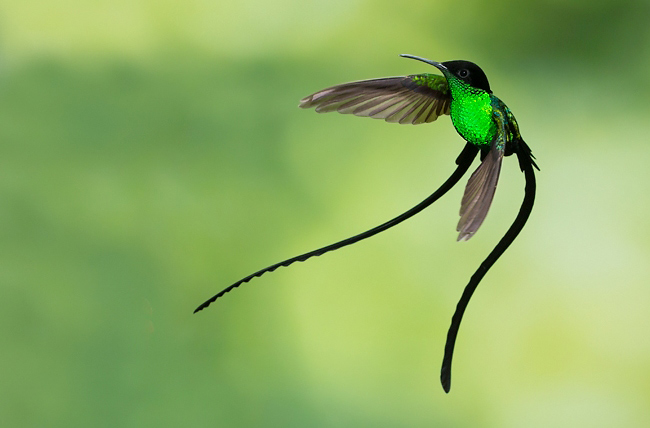
A wonderful image of a Black-billed Streamertail at Port Antonio in Jamaica by Dubi Shapiro.
M
Mexico - Baja California
Whales and dolphins galore, including Blue Whale and confiding Grey Whales, and a few seabirds such as Red-billed Tropicbird, Blue-footed and Masked
Boobies, Black and Least Storm-petrels, and Craveri's and Scipps's Murrelets, while, on land live six endemic landbirds; Xantus’s Hummingbird, Baja
Pygmy-owl, Grey Thrasher, San Lucas Robin, Baird’s Junco and Belding’s Yellowthroat.
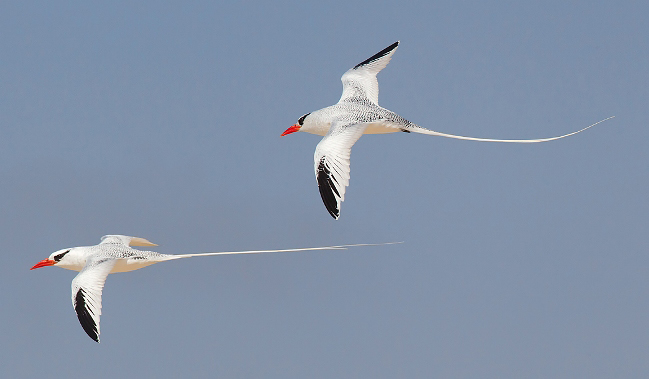
Baja's not all about whales. The birds include Red-billed Tropicbirds. Image by Dave Barnes.
Mexico - Central (Michoacan)
A Top Ten Destination thanks to millions of Monarch butterflies at their winter roosts, many more beautiful butterflies, some
superb Mexican and Central American endemic birds such as San Blas Jay, Aztec Thrush, Chestnut-sided Shrike-vireo, Orange-breasted Bunting and many
colourful warblers, as well as Humpback Whales and Red-billed Tropicbirds along the Pacific coast.
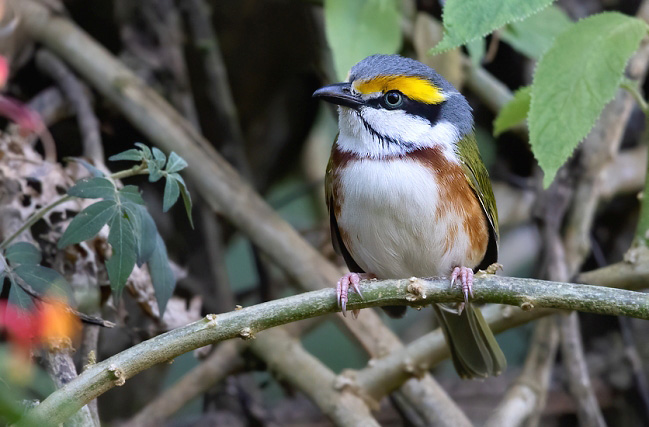
The one-and-only Chestnut-sided Shrike-vireo, in Guatemala, by Dubi Shapiro.
Mexico - El Triunfo
The cloud forest in this reserve in the Sierra Madre de Chiapas is one of the few accessible sites in Chiapas and neighbouring Guatemala where Horned
Guan occurs, and this is also a good place to see other range-restricted highland specialities such as Highland Guan, White-breasted Hawk, Fulvous Owl,
Resplendent Quetzal (the subspecies with the longest tail), Blue-throated Motmot, Green-throated Mountain-gem, Emerald-chinned Hummingbird, Black-throated
Jay, Blue-crowned Chlorophonia and Hooded Grosbeak. At lower altitudes the major speciality is Azure-rumped (Cabanis's) Tanager (most likely at Canada
Honda), while others include Rufous Sabrewing, Sparkling-tailed Woodstar, Tody Motmot, Giant Wren (Tapachula area) and Grey-crowned Ground-sparrow. Other
birds include Turquoise-browed Motmot (Paval area), Black-crested Coquette, Grey Silky-flycatcher and Long-tailed Manakin, and mammals present include
Central American (Geoffrey's) Spider Monkey, Collared Peccary and Southern Ringtail (Cacomistle). Visitors must have permission from the Instituto de
Historia Natural in Tuxtla Gutiérrez which can also help with the logistics in reaching the basic bunkhouse, which involves an uphill hike of about 11
km (6.5 miles), camping lower down, food and so on. The best time to visit is March when Horned Guans are usually calling.
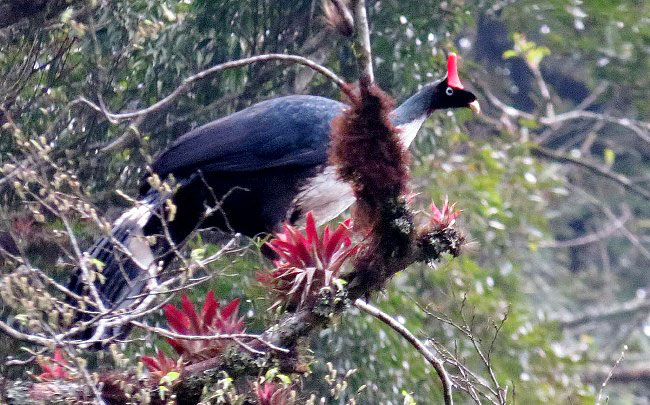
The extraordinary Horned Guan at El Triunfo, Mexico by Jon Hornbuckle. It is only possible to see this bird at remote El Triunfo in southern Mexico or in adjacent Guatemala.
Mexico - Oaxaca
There are probably more bird species in Oaxaca than any other Mexican state; nearly 700, and about a hundred of these are regional endemics. The area around
the city of Oaxaca is also one of the richest regions in Mexico for endemic birds and many of these occur: on Cerro San Felipe (La Cumbre), notable for
Dwarf Jay and lots of warblers including Red; along Route 175 North (the striking Slaty Vireo and, nearer the town of Valle Nacional, Tody Motmot); and
at Monte Alban, home of the skulking Ocellated Thrasher. Other great birds around the city include Grey Silky-flycatcher and Chestnut-sided Shrike-vireo,
with a chance of Aztec Thrush. Further afield, the Sierra Madre del Sur near Puerto Angel on the Pacific coast supports more endemics and Red-breasted Chat
(most likely in Parque Nacional Huatulca), and on pelagic boat trips out of places such as Huatulca and Puerto Angel it is possible, on good days, to see
Townsend’s Shearwater, as well as Galapagos and Pink-footed Shearwaters, Black and Least Storm-petrels, and Nazca (Masked) Booby. At the far eastern end of
the state, live two fantastic endemic birds; Orange-breasted and Rose-bellied (Rosita’s) Buntings, which can be seen side-by-side in the Tapanatepec
Foothills along with such birds as Citreoline Trogon, Russet-crowned Motmot and White-throated Magpie-jay. The endemic Giant Wren (a real giant!) occurs
not far away, near the small town of Puerto Arista in the state of Chiapas, and beyond there in Chiapas lies the Biosphere Reserve Selva el Ocote (Nava's
Wren), El Sumidero Canyon (Belted Flycatcher and a chance of Slender Sheartail) and the warbler-filled woods of San Cristobal de las Casas (Golden-cheeked
and Pink-headed Warblers, and a chance of Blue-throated Motmot and Black-throated Jay). The best time to look for birds is January to April.
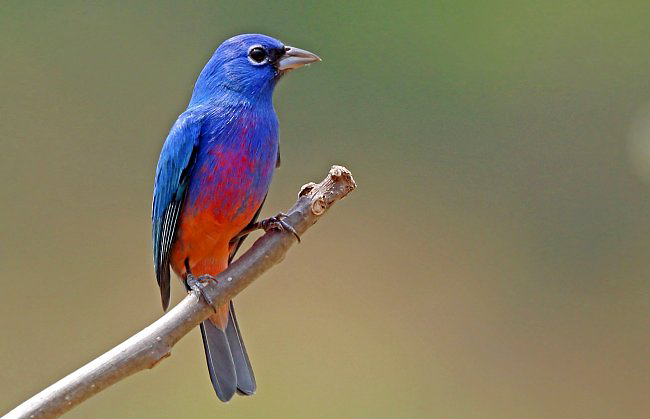
Blue, blue, electric blue, that's the colour of a Rose-bellied or Rosita's Bunting. The superb image of this one was captured in the Tapanatepec Foothills of Oaxaca, Mexico, by Nigel Voaden, the same place the very colourful Orange-breasted Bunting occurs, both species being endemic to Mexico.
Mexico - Southern (Yucatan-Chiapas)
Yucatan bird specialities such as Ocellated Turkey, Mexican Sheartail and Yucatan Jay, more widespread spectacular birds such as Keel-billed Toucan and
Turquoise-browed Motmot, and one of the best places in the world to swim with Whale Sharks.
Mexico - Veracruz
The best place to watch migrating raptors in the world, with 4-6 million birds passing over each autumn/fall in what is known as the ‘Río de Rapaces’
or ‘River of Raptors' and with the 30 or so species of raptor there are sometimes over a million butterflies and dragonflies per day.
Mexico - Western (including the Durango Highway, San Blas, and Colima and Jalisco)
The spectacular endemic Tufted Jay can be seen in the Sierra Madre Occidental, accessible along the Durango Highway, along which also occur the rare
Sinaloa Martin, Red-headed Tanager and Mexico's famous flocks of warblers which here contain Crescent-chested, Olive, Red and Red-faced. Lower down,
specialities include Military Macaw, Purplish-backed Jay and wintering Black-capped Vireos. At the coast, on the Gulf of California, rocky islets
viewable (with telescopes) from Mazatlan support breeding Red-billed Tropicbirds and Blue-footed Boobies. Further south along the Pacific coast lies
the small holiday resort of San Blas where it is possible to see 250 species in a week, less than a thousand miles south of the U.S. border, including
about 30 endemics (such as Citreoline Trogon and San Blas Jay), as well as Rufous-necked Wood-rail, Bare-throated Tiger-heron, Boat-billed Heron, Collared
Forest-falcon, Northern Potoo, Military Macaw, Russet-crowned Motmot, Fan-tailed Warbler and the unique Rosy Thrush-tanager. Humpback Whales spend the
northern winter in Banderas Bay, Puerto Vallarta, where on organised whale-watching trips it is also possible to see Bottlenose and Spotted Dolphins. Not
much further south is the small state of Colima which together with parts of neighbouring Jalisco supports about 40 endemics including San Blas Jay, Aztec
Thrush, Red Warbler and Orange-breasted Bunting, as well as Grey Silky-flycatcher, Chestnut-sided Shrike-vireo, many warblers including Colima and
Golden-browed, and Red-breasted Chat. The smoking Volcan de Fuego is one of the best sites, although the vast flocks of Yellow-headed Blackbirds winter on
the Ciudad Guzman Marshes. At the coast, boat trips can be arranged out of Manzanillo to a big rock called Piedra Blanca where Red-billed Tropicbirds
breed. The best time to bird Western Mexico is January-February.
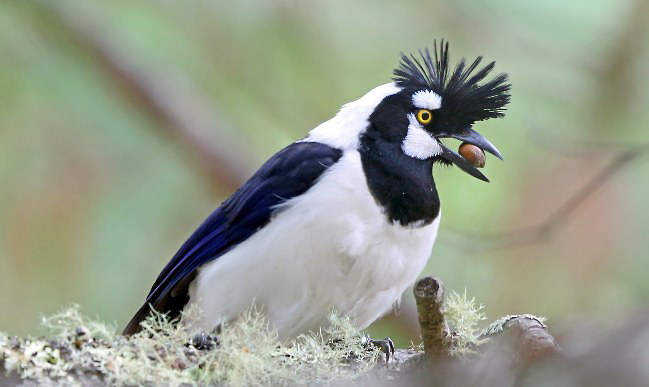
The striking Tufted Jay at Reserva Chara Pinta by Nigel Voaden.
N
Nicaragua
Although the largest country in Central America has long been overshadowed by its southern neighbour Costa Rica as far as birding goes it still has swathes
of good forest, especially in the Caribbean lowlands where the Indio Maiz Reserve and Rio Indio Lodge are situated. Elsewhere there are Pacific slope
forests, highland forests and the huge Lake Cocibolca (Lake Nicaragua) which together support the near-endemic Green-breasted Mountain-gem (El Jaguar
private reserve), Nicaraguan Seed-finch and the virtually endemic Nicaraguan Grackle, as well as Great Curassow, Agami Heron, Bare-throated Tiger-heron,
Green Ibis, Great Green and Scarlet Macaws, Resplendent Quetzal, trogons, Black-crested Coquette, Snowcap (Refugio Bartola), Turquoise-browed Motmot,
Keel-billed Toucan, Ocellated Antbird, Bare-necked Umbrellabird, Three-wattled Bellbird, Long-tailed and Red-capped Manakins and Golden-cheeked Warbler,
while mammals include Mantled Howler and Geoffrey’s Spider Monkeys, and Brown-throated Three-toed Sloth. Some of the best birding sites are Montibelli
private reserve near Managua, Refugio Bartola on the Rio San Juan and El Jaguar private reserve. The rainy season normally runs from May to November when
hurricanes are also possible. Hurricane Otto made landfall in November 2016 and affected the forests around Refugio Bartola and in the Indio Maiz
Reserve.
O
Oaxaca - Mexico
See Mexico - Oaxaca, above.
P
Panama
Nearly a thousand bird species including nine endemics, 74 species shared with Costa Rica and 27 species shared with Colombia, a multitude of birds that
includes Harpy Eagle, many hummingbirds, Resplendent Quetzal, Sapayoa, Black-crowned Pittasoma, Black-tipped, Blue, Turquoise and Yellow-billed Cotingas,
Long-tailed Silky-flycatcher, Golden-browed and Yellow-collared Chlorophonias, and Wrenthtrush, with a rich offshore life too where there are Manta Rays
and turtle cleaning stations.
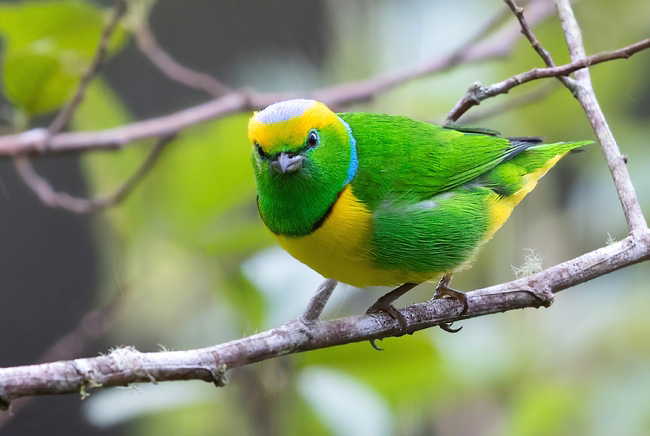
Golden-browed Chlorophonia, Cabanas Los Quetzales, Panama, by Dubi Shapiro. This beauty occurs only in Panama and Costa Rica.
Puerto Rico
This small island supports an endemic monotypic bird family (Puerto Rican Tanager) and 15 other endemic birds; a nightjar, two hummingbirds, a
lizard-cuckoo, a tody, a woodpecker, a parrot, a vireo, a euphonia, an oriole, a blackbird, two warblers, a spindalis and a bullfinch, as well as two
species shared with the Virgin Islands only; Puerto Rican Screech-owl and Puerto Rican Flycatcher. The parrot is very rare and unlikely to be seen even
where most of the wild and released birds are, in the Caribbean National Forest (El Yunque) in the Sierra de Luquillo, particularly at Rio Abajo. Other
Caribbean endemics include two more hummingbirds and Eastern Red-legged Thrush while other spectacular species present include White-tailed Tropicbird,
Magnificent Frigatebird and wintering warblers from North America such as Prairie. It is possible to see all of the endemics except the parrot in a few
days hence many birders combine a trip to this island with the Dominican Republic. Other natural wonders include the karst country of the northwest where
there are many similar sized and shaped 100 ft (30 m) high hillocks or mogotes; the Rio Camuy Caves, also in the northwest, one of the largest cave systems
on the planet covering 268 acres (110 ha); and Mosquito Bay on the island of Vieques which at night all year round glows blue-green thanks to the presence
of millions of microscopic phosphorescent dinoflagellates, best experienced while swimming on a cloudy moonless night. The best time to look for birds is
March-April.
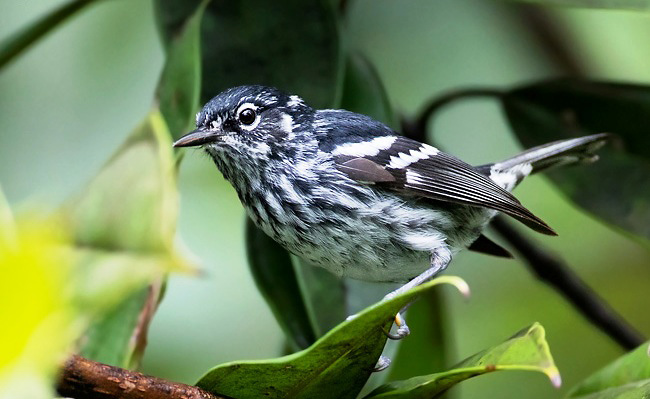
Elfin Woods Warbler at El Yunque by Dubi Shapiro.
S
St Lucia
This Caribbean island is just 43 km (27 miles) long and 23 km (14 miles) wide. Its forested slopes support the richest avifauna in the Lesser Antilles
including four endemic bird species; a parrot, an oriole, a warbler and a black finch, with three more possibles; the island forms of Rufous Nightjar,
House Wren and Lesser Antillean Pewee. The last reliable sighting of another endemic, Semper’s Warbler, was in 1961 and there have been no unconfirmed
reports since 2003 so it may be extinct although areas of suitable habitat remain. There are also several Lesser Antillean endemics; Lesser Antillean Swift,
Purple-throated Carib, Lesser Antillean Flycatcher, Scaly-breasted and White-breasted Thrashers, Grey Trembler, Lesser Antillean Euphonia, Lesser Antillean
Saltator and Lesser Antillean Bullfinch, and four more widespread Caribbean endemics; Bridled Quail-dove, Green-throated Carib, Antillean Crested
Hummingbird and Rufous-throated Solitaire. Other spectacular species include Red-billed Tropicbird (most likely at Cape Moule à Chique at the southern tip
of the island), Magnificent Frigatebird and Mangrove Cuckoo. The Des Cartiers Trail in Quilesse Forest Reserve, about two hours south of Anse Chastanet,
is arguably the best forest trail on the island. On boat trips off Soufriere, Fraser's, Spinner and Pantropical Spotted Dolphins are possible and also
offshore there are many coral reef fishes, and Green and Hawksbill Turtles. The best time to look for birds is February-April.
T
Trinidad and Tobago
Some fine birds including the endemic Trinidad Piping-guan and Trinidad Motmot, the near-endemic White-tailed Sabrewing, and more widespread species such
as Red-billed Tropicbird, Magnificent Frigatebird, a large roost of Scarlet Ibises, a cave colony of Oilbirds, Ruby Topaz and Bearded Bellbird, as well as
nesting turtles and coral reef fish.

A male Ruby Topaz hummingbird on the island of Trinidad by Steve Garvie.
Turks and Caicos Islands
This UK Overseas Territory is a small archipelago of low-lying islands and cays south of the Bahamas in the Caribbean. It supports 58 native breeding
birds including important colonies of gulls, terns and other seabirds (mainly April to July) such as White-tailed Tropicbird, Magnificent Frigatebird
and Brown Noddy. For example, Big Sand Cay has a colony of Sooty Terns, as well as Hawksbill Turtles. Other birds present include West Indian
Whistling-duck, Reddish Egret, Greater Flamingo, Key West Quail-dove, Antillean Nighthawk (mainly May-Aug), the near-endemic Bahama Woodstar, Thick-billed
Vireo, Bahama Mockingbird, Pearly-eyed Thrasher, Cuban Crow, Western Spindalis and Greater Antillean Bullfinch, while 110 regular passage migrants and
winter visitors include Piping Plover and Kirtland’s Warbler. Humpback Whales migrate south through the islands in January to March, on their way to the
Silver Bank, north of the Dominican Republic.
V
Veracruz - Mexico
See Mexico - Veracruz, above.
Y
Yucatan - Mexico
See Mexico - Southern, above.

